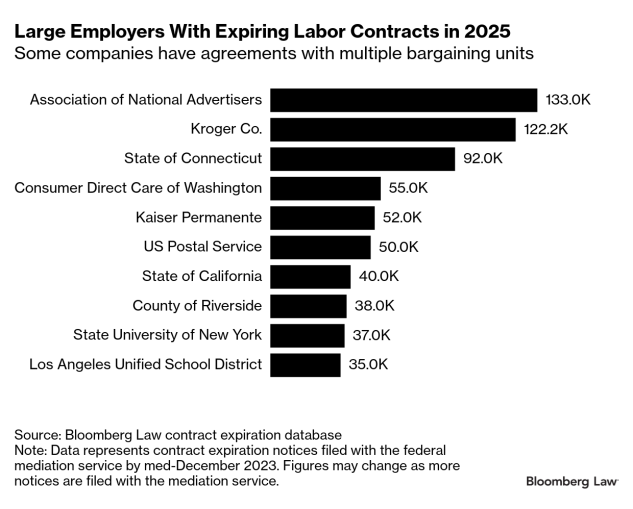- 1.5 million workers under large union contracts expiring in 2025
- Trump has historically stayed out of labor disputes
Nearly 200 large union contracts are set to expire in 2025, opening up possibilities for labor unrest in the early months of
The contracts cover more than 1.5 million workers across a swath of industries, according to Bloomberg Law data available as of mid-December 2024.
The earliest chance for a strike—and potentially the first labor test for the incoming administration—could come from 45,000 longshoremen at docks along the US East and Gulf coasts. Talks for a new labor pact resume this week ahead of the contract’s Jan. 15 expiration.
About 18,000
Other expiring labor agreements this year cover 133,000 commercial singers and voice actors with SAG-AFTRA, over 122,000
Workers will likely be emboldened to strike based off the record-breaking wages and benefits secured in contracts from the last few years, such as with Detroit’s Big Three, the Boeing Co., and Hollywood production studios, labor observers said. They’ll also push for novel job protections from emerging technology like artificial intelligence, they said.
“The workers know what it takes to go on strike and they also know what they can get from going on strike,” said Rebecca Givan, an associate professor of labor studies and employment relations at Rutgers University. “And employers know that the strike threat is very real, it’s not just empty rhetoric.”
However, observers said both unions and management may not be able to count on Trump officials to help them with negotiations, as they have in high-profile standoffs during the Biden era.
Trump’s Labor Chops
For example, Acting Labor Secretary Julie Su stepped in to help broker talks at Kaiser Permanente after workers launched the largest US health-care strike, and at Boeing where union members shot down the company’s proposals several times to hold out for large wage and retirement benefits increases.
President Joe Biden walked the picket line with striking members of the United Auto Workers union when they coordinated strikes at
Harry Katz, a labor professor at Cornell University, said unions might not have that kind of support under
“I won’t mention the name of the company, but they go on strike, and you say ‘That’s OK, you’re all gone,’” Trump said in an August conversation with Elon Musk on X, which drew unfair labor practice charges from unions.
But in a more recent pivot, Trump said he would nominate Lori Chavez-DeRemer—a rare pro-union Republican with ties to the Teamsters—as his labor secretary and voiced his support for the dockworkers’ demands in a December statement.
Trump and his officials largely stayed on the sidelines with labor disputes during his first administration so it’s not “completely clear” what his support for workers might look like this time around, Katz said.
“He doesn’t have a history of supporting labor unions and the people he appoints are not going to be the experienced mediators that can actually help in these disputes,” he said.
“President Trump will keep his promise to the hardworking men and women of America by bringing jobs back home, restoring American manufacturing, slashing inflation, and cutting taxes.” said Karoline Leavitt, a spokesperson for the Trump-Vance transition team.
Shifting Technology
A theme that will likely resonate throughout contract negotiations in 2025 is the integration of technology and AI, said Givan.
AI use was central in the dispute between 60,000 Hollywood actors and production studios, which led to a 118-day strike. The union said it got the entertainment industry to agree to “unprecedented restrictions” on the use of AI to re-create an actor’s likeness.
This year, SAG-AFTRA will head back to the bargaining table, this time for voice actors who will likely have many of the same concerns.
Biden’s Labor Department has sought to place guardrails over employers’ use of AI to ensure that they don’t use the technology to make “significant” employment decisions, and that they provide disclosures to workers and unions about how it’s being used. Biden also directed efforts aimed at preventing AI systems from discriminating against workers in a 2023 executive order. The policies are still in their infancy however, leaving much of the nitty gritty details to be settled between companies and unions.
“The use of AI in any contract with creative work is going to be absolutely central,” Givan said of SAG-AFTRA’s upcoming negotiations. “We all have experience with the way AI voices can sound and the whole voice over industry could be turned upside down by it in the next couple of years.”
Technology integration will also be pivotal in talks with the dockworkers, who are fighting for protections against increased automation. Katz said the dispute will be difficult to settle with the fractured nature of the US Maritime Alliance, which is comprised of 40 shipping lines and port operators.
“When you have so many different entities trying to resolve complex issues like technological change, it’s difficult. It’s hard to come up with creative win, win solutions so both parties can potentially benefit,” he said.
To contact the reporter on this story:
To contact the editors responsible for this story:
Learn more about Bloomberg Law or Log In to keep reading:
See Breaking News in Context
Bloomberg Law provides trusted coverage of current events enhanced with legal analysis.
Already a subscriber?
Log in to keep reading or access research tools and resources.

